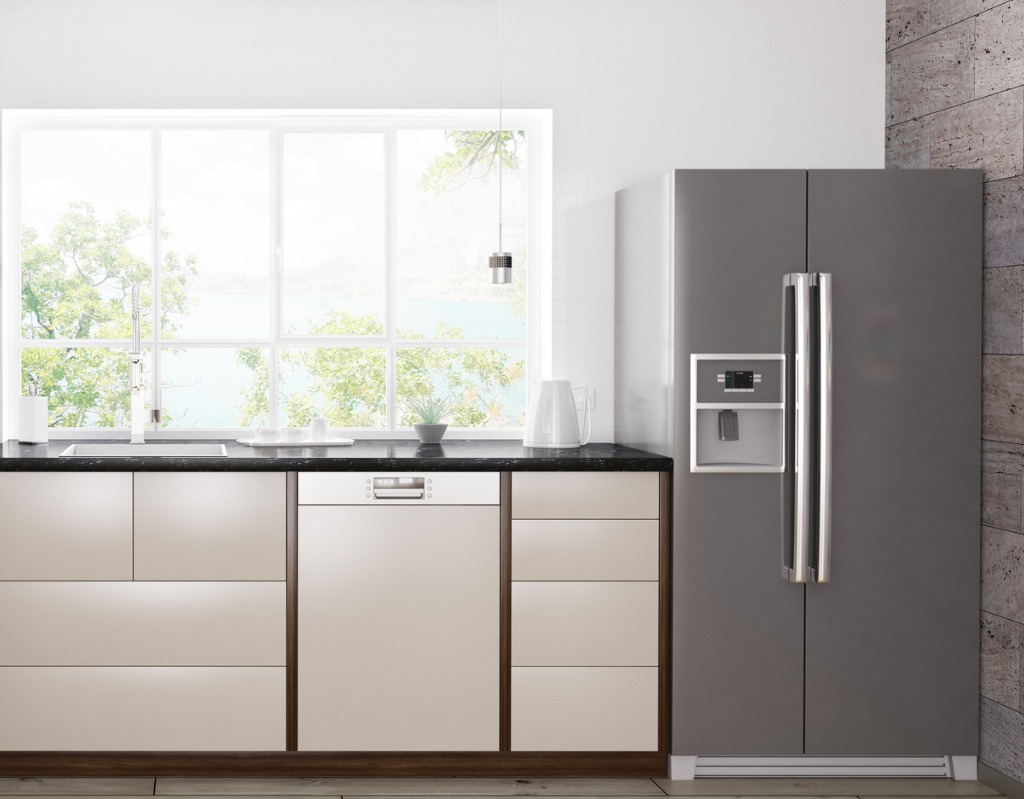We may earn revenue from the products available on this page and participate in affiliate programs. Learn More ›
Q: My current fridge is on its last leg, so I’m starting to look for a new one. With all of the different sizes and models available right now, I’m having a hard time figuring out how many cubic feet are in a standard refrigerator, and if I should get something bigger than average for my family of four (with two soon-to-be teenage boys).
A: Refrigerators come in such a wide range of lengths, heights, depths, and capacities that it certainly can be a challenge to know which size to purchase. Plus, there isn’t one standard refrigerator size. Refrigerator sizes can vary, and are specific to each style (such as top freezer or French door).
Ultimately, the best refrigerator for your household will be one that offers ample storage to keep foods fresh and fits properly in the available space without impacting the flow of people or making the room feel too cramped.
Common Refrigerator Styles
A typical refrigerator’s dimensions are based on its type. The most common types and their standard dimensions include the following.
- Full-Width Door with Freezer on Top or Bottom: Top freezer refrigerators are generally among the least expensive models and have two full-width doors that open in the same direction. Bottom freezer refrigerators place the refrigerator section of the unit on top to keep fresh foods at eye level and easier to access. These models include a pull-out bottom drawer freezer. The standard dimensions for a full-width door fridge are: 23 to 36 inches wide and 65 to 69 inches tall.
- Side-by-Side Fridge and Freezer Doors: Both refrigerated and frozen items can remain at eye level with a side-by-side refrigerator. You’ll often gain freezer space with these models, but will lose a bit of refrigerator space. The standard dimensions for a side-by-side refrigerator/freezer are: 30 to 36 inches wide and 67 to 70 inches tall.
- French Door Refrigerator with Freezer on Bottom: French door refrigerators are designed to maximize food-storage space. They feature two half-width doors that open to reveal a large full-width refrigerator space and a bottom pull-out drawer freezer. The standard dimensions for a French door refrigerator are: 30 to 36 inches wide and 67 to 70 inches tall.

Depth Considerations
Both standard-depth and counter-depth refrigerators are available. A standard-depth refrigerator is generally between 30 and 36 inches deep. This depth extends past the edge of kitchen cabinets, so it will take up more space in a kitchen. However, with the extra depth, there will be more storage space inside these models.
Counter-depth refrigerators, as the name implies, are about as deep as typical kitchen counters and cabinets, around 23 to 27 inches deep. These models can provide more of a built-in look since they are flush with the cabinets. Also, since they don’t stick out past the edge of the cabinets, they won’t inhibit traffic flow like a standard depth refrigerator may. On the other hand, the more compact size means a little less interior storage space.
Clearance for Doors and Drawers
A refrigerator must fit in the available space, but you also need sufficient space to open the doors and drawers. Measure to make sure there is enough space to fully open the doors and pull out any drawers without hitting the walls. Ideally, you should aim for 2 or more inches of space between the door hinge and the wall to prevent dents and dings and ensure proper operation.
To make sure doors and drawers will open fully, you also need to measure the available space in front of where the refrigerator will be. Look for models with door widths and drawer depths that are narrower than this available space to prevent opening the door into a cabinet, island, or other appliance in the space. Depending on the layout of the kitchen, you may also want to look for a model that is compact enough to allow others to walk freely when the refrigerator is open. However, this walking space isn’t always a possibility, even with more compact refrigerators in galley kitchens or other tight spaces.
As you’re measuring the space, keep in mind that there also needs to be space behind the refrigerator to allow air to circulate. This means you shouldn’t push the refrigerator flush against the wall. To account for this needed space, add an extra 2 inches to the depth when measuring.
Related: What’s the Deal with Fingerprint-Resistant Stainless Steel Appliances?

Path to the Kitchen
If you have the space for it, getting a bigger fridge may sound like a great idea. However, if the refrigerator is too big to make it through the pathway to your kitchen, it won’t do you any good. Look for the shortest path from the exterior of the home that has the least number of turns or other obstacles.
Measure any tight doorways or pass-throughs to ensure the new refrigerator will be able to make it through. The doors to a new refrigerator often arrive uninstalled, which should make it easier to maneuver. You may also need to remove doors in your home to create a wide enough path. Many delivery companies complete this step for you, but some will not. It is best to check and see if you’ll need to be prepared to take off a door at the time of delivery.
When to Go Bigger
If you have space to fit a refrigerator larger than a standard size, should you go bigger? There are definitely some benefits associated with getting a bigger refrigerator. These include increased food storage and more space to keep things organized.
However, a larger refrigerator also requires more energy to operate, which can increase utility bills. With all the additional interior space, items also are more likely to get lost and forgotten. This can increase food waste.
Deciding whether to go bigger is a personal decision. You’ll need to weigh these pros and cons against your priorities and preferences.


